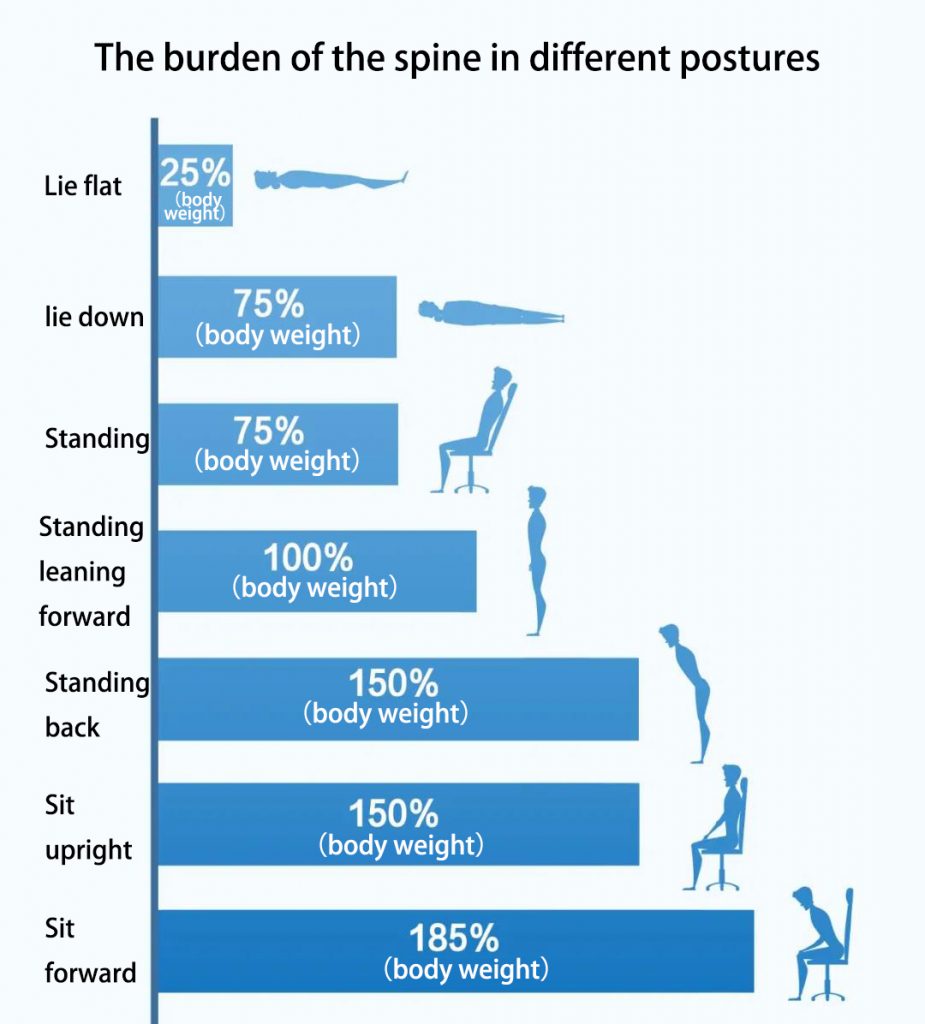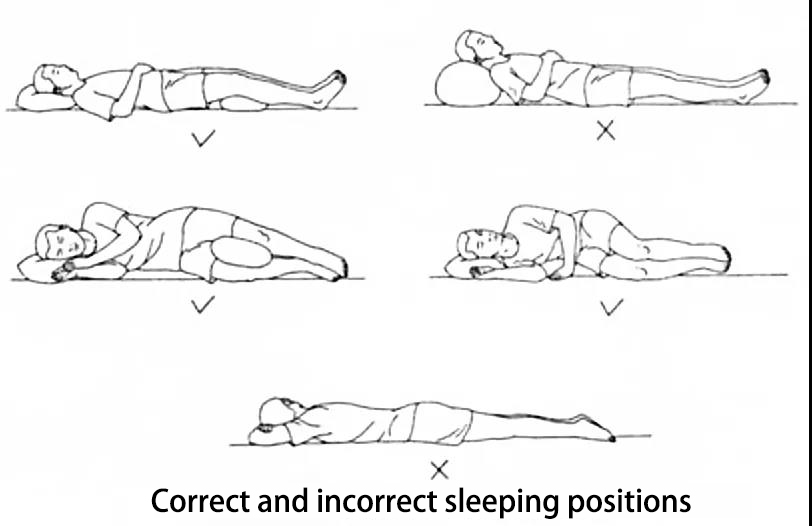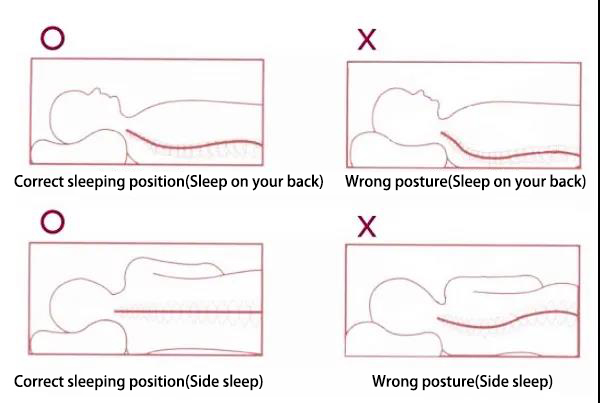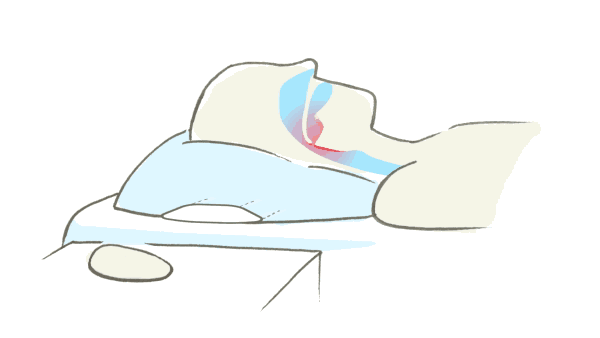
People who often have neck discomfort or back pain may have experienced this:
No matter standing or sitting, the uncomfortable pain is always there accompanied you. Only when you lie down you feel a little comfortable.
In the eyes of orthopedic doctors, lying flat is the favorite posture of the spine, and the pressure it bears is only 1/4 of that of standing.

Use picture to show the stress on the spine in different postures, and teach you a comfortable and healthy lying posture.
Lying flat, the most comfortable posture for the spine
When lying flat, the spine receives the least pressure, as shown in the picture below.

For example, for a person weighing 100 kg (50 kg), in different positions, the weight on the waist is different:
When lying flat, the load on the lumbar spine is minimal, about 12.5 kg;
When lying on the side, the lumbar spine load is about 34.5 kg;
When standing, the lumbar spine load is 50 kg;
When sitting, the upper body is upright and the lumbar load is 75 kg…
When lying flat, the pressure on the spine is about 1/4 of that when standing and 1/6 of that when sitting upright.
Follow up 3 principles and lie down more healthily
To lie down comfortably without hurting your body, you must know these knowledge about lying down.
1.In correct posture
When sleeping, lie as flat as possible, slightly sideways, so that the spine maintains a natural alignment, legs slightly curled up, knees can be raised with a low pillow, 15 degrees to the bed surface.
Overweight people should not lie on their backs. They can choose to lie on the right side, with the right leg bent and the left leg on the right leg, similar to a “reclining Buddha”.
No one should lie down on their stomachs, so as not to compress the chest cavity.

2. Two pillows
Whether lying on your back or lying on your side, it is best to prepare two pillows, one for your neck and one between your knees.
Cervical Pillow
Lying flat can best maintain the natural curvature of the cervical spine. It is best to choose a pillow with a thin middle and high on both sides; moderate height (usually a punch high at the edge) and medium hardness to ensure that the cervical spine will not bend or extend excessively.
When lying flat, the width of the pillow should be just from the head to the neck, and the cervical spine should not be suspended in the air. The thickness of the pillow should be just the distance from the plane of the back to the normal flexion of the neck.

When lying flat, generally place the head and neck in the depression in the middle of the pillow, so that the pillow fulcrum is located in the middle of the back of the neck and is adapted to the curvature of the back of the neck.
Knee pillow
Putting a lower pillow on the knee can avoid excessive traction of the spine, especially the lumbar spine, and keep the spine and head in a straight line, and the hip joint and pelvis will also be maintained in a comfortable state.
3. Turn over frequently
You can lie down or sit while resting, but change your posture every 10-15 minutes.
These lying positions are secretly hurting you
If the correct lying posture can relax the spine and allow all parts of the body to have a chance to repair themselves, then the following lying postures will harm you secretly.
Half-lying, reclining
Injury to the intervertebral disc
If you use bad postures such as leaning or half-lying while resting, your body will bend unnaturally. Especially when half-lying, the lumbar spine lacks sufficient support and the intervertebral disc is stressed, which can easily induce or aggravate muscle strain, scoliosis, cervical spondylosis, low back pain, and lumbar disc herniation.
Lying flat
Harmful to overweight people’s respiratory tract
We advocate lying on your back, but we don’t recommend obese people lying on their backs for a long time. When lying flat, the tongue is under the action of gravity, and the tongue droops naturally to the back of the mouth, narrowing the respiratory tract.

It is not difficult to find in life that many people snoring loudly when lying on their backs, and the snoring sounds less after turning over and lying on their side, especially fat people. Severe snoring can lead to obstructive sleep apnea hypopnea syndrome, which affects sleep quality, physical strength and energy during the day, and damages physical and mental health.
Sleep on the stomach
Compress the heart and lungs
Whether lying on the stomach or on the left side, it will cause compression on the heart and lungs. Sleeping like this will affect the circulation of qi and blood throughout the body, causing heart discomfort and breathing difficulties.
Sleep with head on the arms
Compress the nerves
Many people like to pillow their arms, which will cause compression damage to the radial nerve of the upper arm, causing paralysis of the forearm, wrist and fingers.
In addition, being in bed for a long time can cause muscles and ligaments to become loose and weak, causing problems such as stiffness, soreness, and atrophy.
Don’t mess around! Best to lie down in the following 7 situations
Not all “resting” should lie still, but if you unfortunately suffer from the following diseases, then lying on your back will be more conducive to the recovery of the disease if you are suffering from the following diseases.
1. Spinal disease
Patients with bone hyperplasia and muscle strain do not need to stay in bed, but can often do health exercises on the neck and waist; disc herniation accompanied by nerve compression symptoms, need to stay in bed for 2-3 weeks.
2. Fracture
Do some “passive” exercises with the help of your family. For example, in patients with meniscus injuries, the knee joints should be bent at different angles to avoid joint stiffness.
3. Heart disease
Bed rest in the acute phase, semi-recumbent or right-side lying position will help blood circulation; in the chronic rehabilitation phase, there is no need to rest in bed, and you can walk slowly, do Tai Chi, etc.
4. Stroke
Carry out rehabilitation training as soon as possible after the condition is stable, and avoid long-term bed rest.
5. Stomach and esophagus diseases
Choosing to lie on the left side can reduce the flow of gastric acid into the esophagus and reduce the burning sensation in the stomach.
6. Catching a cold
You don’t need to stay in bed for mild illness, and you can stay in bed for 3 to 5 days if you have a severe cold with fever.
7. Poor spirit
A Turkish study found that 40.9% of those sleeping on the left reported that they often had nightmares, while only 14.6% of those sleeping on the right had such a situation. If you feel mentally tired or nervous, avoid sleeping on the left side.
Finally, keep in mind that two “can’t lie down”:
1. Do not lie down immediately after a meal. Walk and move first, and then lie down after 30 minutes.
2. Do not lie down immediately after taking the medicine. Stand or walk around for 5 minutes, then lie down to rest.
Comments